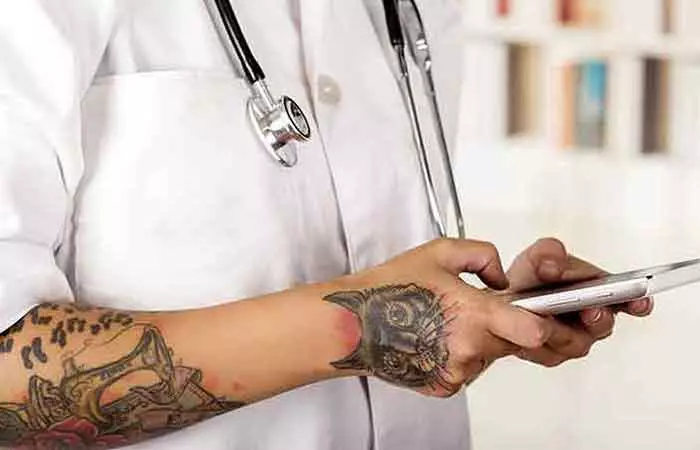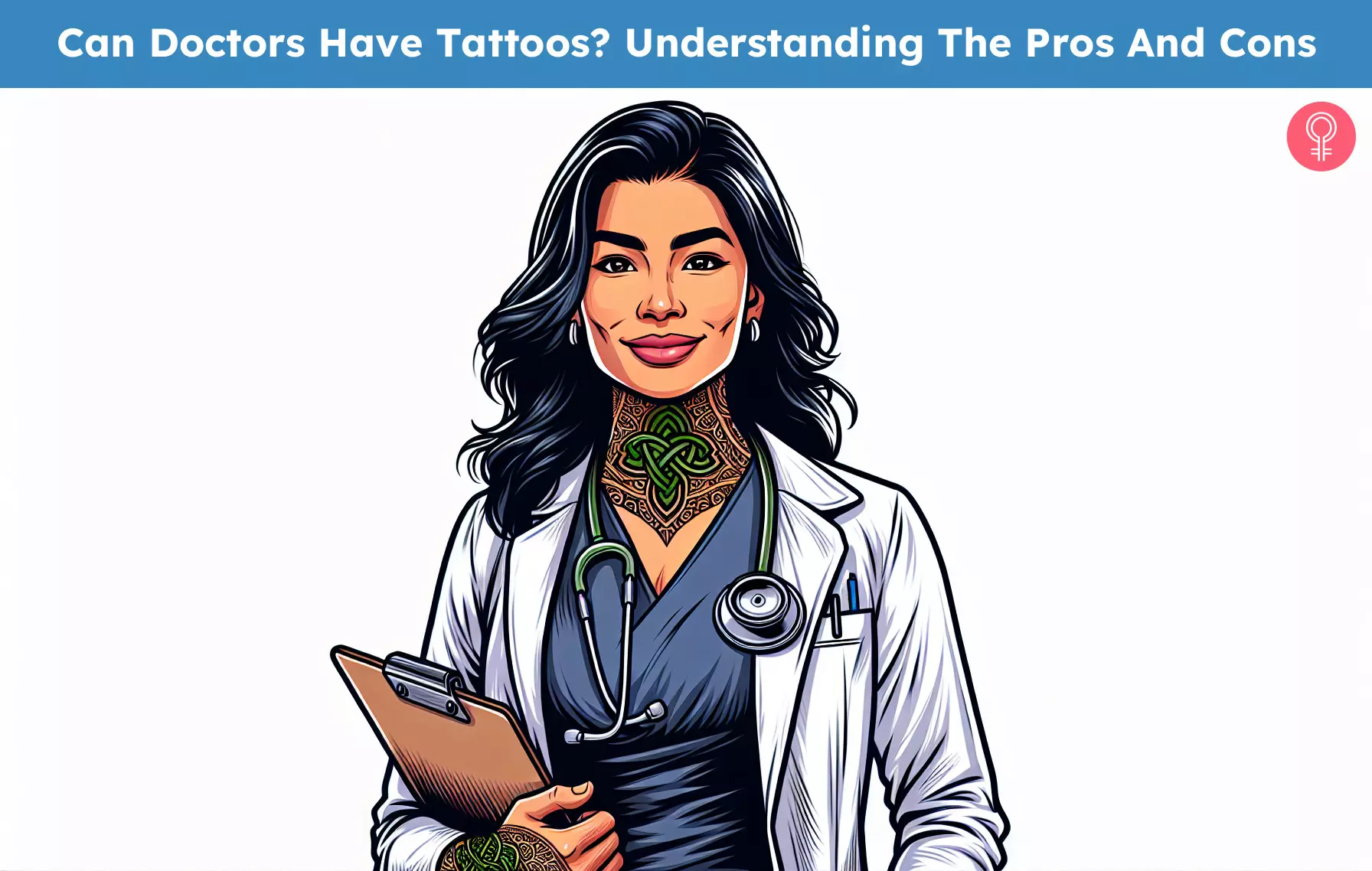
A nice blouse or collared shirt and a lab coat is the usual image we have of a doctor. We never think of them with facial piercings, orange hair, or a sleeve full of tattoos. But that begs the question: “Can doctors have tattoos?”
Tattoos are becoming increasingly popular as a symbol of personal expression and identity in a conservative profession like medicine. However, many still do not support doctors in this field having body ink or body piercings. So if you have a passion for this beautiful piece of body art but don’t know what to do, you’ve come to the right place. In this article, we’ll take a closer look at whether doctors are allowed to have tattoos and what guidelines you should follow. Scroll down to learn more.
Should doctors be allowed to have tattoos?
 Image: Shutterstock
Image: Shutterstock
There is still a certain conservatism in medicine when it comes to doctors with lip piercings, blue hair, and tattoos. That said, there are no rules or laws that prohibit doctors from wearing tattoos. However, guidelines and policies regarding tattoos vary by healthcare institution. Some ask their hospital staff and physicians to cover up visible body art at work for hygiene purposes or to give their patients a more professional appearance. Others allow their hospital administrators, medical technicians, and physicians to display their visible tattoos at work to create a supportive and comfortable environment. Therefore, check your hospital’s guidelines to help you better navigate your workplace.
Doctors are allowed to wear tattoos in institutions with relaxed policies around them. But are there any restrictions on the types of tattoos they can display? Read on to find out.
What tattoos are allowed for doctors?
 Image: Shutterstock
Image: Shutterstock
Doctors are allowed to wear tattoos as long as they do not contain explicit or inappropriate content related to a specific gender, race, religion, violence, hate speech, political beliefs, or nudity. However, they must follow proper hygiene practices to ensure they do not interfere with medical procedures or increase the risk of infection.
If you are planning to get a tattoo, here are some things you may want to consider:
Make sure you are not allergic to tattoo ink. Let your tattoo heal completely (about 4 to 6 weeks) before returning to work. Consult your tattoo artist and select an area that is less visible or easy to hide in a clinical setting.
Dr. Sarah Gray is the most tattooed doctor in the world. She has spent over 300 hours getting tattooed.
While medical regulations vary by state and even by hospital setting, there are certain general guidelines that most medical facilities adhere to when it comes to their tattoo policies. Find out what these guidelines are in the next section.
Guidelines for doctors to get tattoos
 Image: Shutterstock
Image: Shutterstock
These are some general guidelines that apply to people pursuing a career in medicine:
1. Visibility Guidelines
Most medical facilities ask their doctors to cover arm, neck, face, or sleeve tattoos with gloves, scrubs, or face masks. This is because they can be distracting to many patients and even the other medical professionals working there.
2. Differences in policy
Some hospitals allow doctors with visible tattoos as long as they are not offensive and do not come across as disrespectful. However, this can vary from medical institution to medical institution. Therefore, check your current employer’s policy regarding tattoos to find out what you should do.

You can use a concealer or foundation to cover your tattoos. Finish it off with a setting powder to ensure that the makeup stays put all day.
The general guidelines above can help you navigate your daily life as a doctor. That said, there are certain pros and cons to having tattoos as a doctor. Check out the next section to learn more.
Pros and Cons of Doctors Having Tattoos
 Image: Shutterstock
Image: Shutterstock
Advantages
Many medical professionals choose to get a tattoo for the following reasons:
1. To express individuality
Doctors are often expected to maintain a professional yet conservative image that can sometimes limit their freedom of expression. However, many doctors get tattoos to stay connected to their family and roots or as an expression of themselves.
2. To build a bond with patients
Doctors with tattoos may seem more relatable to patients. For example, a doctor with an octopus or butterfly tattoo may seem more approachable to many patients, especially older patients. This can help them build a rapport with their patients, leading to a comfortable and satisfying patient experience.
3. To increase trust
Doctors who get meaningful tattoos can increase their self-confidence and feel more comfortable in their own skin. This can also help increase their productivity at work. This in turn can increase their job performance and satisfaction.
4. To promote inclusivity
Physicians with visible body art can help break down stereotypes associated with tattoos and create a more diverse and inclusive work environment.
Mansi Singhal, a doctor, shared her experience with tattoos as a healthcare professional in her vlog. She said, “I am still in the early stages of my professional career, but I can say that I have not had anyone look at my tattoos and tell me that I cannot continue in my profession (ⅰ).”
Disadvantages
There is also a downside to doctors having tattoos. Read more below:
1. May negatively impact their professional image
Many patients believe that the tattoos they see on doctors make them less professional, approachable, or even ineffective. This can lead to a lack of trust between patients and doctors, which can reduce patient satisfaction and make them less likely to return for follow-up appointments.
2. Can distract patients
The bright, colorful appearance of tattoos can distract both fellow physicians and patients, potentially leading to incorrect diagnosis or treatment and endangering the patient’s life.
3. May lead to possible prejudices
Medical professionals with tattoos are seen as less professional or hardworking by their senior colleagues. This can ruin future opportunities and hinder their career progression.
The social stigma associated with tattoos in the medical field still exists. However, doctors still get tattoos to express themselves, despite the stereotypes. While there are no rules or laws that prohibit doctors from having tattoos, each medical institution has its own rules regarding tattoos. In most cases, doctors with visible tattoos are required to cover them with makeup, medical tape, or scrubs and follow proper hand hygiene to prevent contamination. Others allow doctors to display their tattoos to create a more inclusive work environment. Therefore, it is advisable to check your employer’s current policy on tattoos to help you navigate your daily life as a doctor.
Frequently Asked Questions
What should doctors pay attention to when applying tattoos in visible areas?
Doctors should consider the content when getting a tattoo. One should avoid inappropriate themes and symbols that may offend the religious and cultural feelings of others. In addition, they should consider the size before getting their tattoos.
Do healthcare dress codes take tattoos into account?
This can vary by healthcare facility. Some may ask their doctor with tattoo sleeves to cover them with makeup or long-sleeved scrubs for a more professional look. Others may have more relaxed rules regarding tattoos and may simply ask the doctor to dress appropriately.
Key Points
The cultural acceptance of tattoos can vary from healthcare facility to facility in terms of their policies and attitudes. Physicians with tattoos may be required to cover them with makeup or medical tape while on duty. Many hospitals are okay with physicians having tattoos. However, they prohibit tattoos that are associated with violence, racism, political views, etc. Tattoos can help create an inclusive environment in the workplace, but can make the patient population appear less professional and caring.
Image: Dall·E/StyleCraze Design Team
Tattoos are a hot topic in the medical community. Watch this video for important information on how to navigate the world of medicine as an aspiring physician.
Personal experience: Source
StyleCraze’s articles are interwoven with authentic personal stories that add depth and resonance to our content. Below are the sources of the personal accounts referenced in this article.
(ⅰ). Should doctors be allowed to have tattoos?!https://www.youtube.com/watch?v=b_y7VllfOr4Was this article helpful? ReviewerAuthorEditorFact Check
![]() Brik Rangel is a highly skilled tattoo artist with 12 years of experience in the field. She specializes in transformative tattoo makeovers and cover-ups. After honing her craft in São Paulo, Brazil, she now works as a tattoo artist and manager at Manhattan Tattoos in New York and as a tattoo artist at Divine Tattoos in New Jersey.
Brik Rangel is a highly skilled tattoo artist with 12 years of experience in the field. She specializes in transformative tattoo makeovers and cover-ups. After honing her craft in São Paulo, Brazil, she now works as a tattoo artist and manager at Manhattan Tattoos in New York and as a tattoo artist at Divine Tattoos in New Jersey.
Read Brik Rangel’s full biography
![]() Joyce Joyson is a beauty and lifestyle writer with over a year of experience in creating short-form content for the beauty, fashion and lifestyle niches. She holds a Bachelor’s degree in History, Political Science and Geography from IIS University and a Master’s degree in Mass Communication and Journalism from Kristu Jayanti College.
Joyce Joyson is a beauty and lifestyle writer with over a year of experience in creating short-form content for the beauty, fashion and lifestyle niches. She holds a Bachelor’s degree in History, Political Science and Geography from IIS University and a Master’s degree in Mass Communication and Journalism from Kristu Jayanti College.
Read Joyce Joyson’s full biography
![]() Eshna is an associate editor and certified skin care coach. She has over three years of experience, a triple major bachelor’s degree in psychology, English and journalism from Mount Carmel College, Bengaluru, and a master’s degree in psychology from Sampurna Montfort College, Bengaluru.
Eshna is an associate editor and certified skin care coach. She has over three years of experience, a triple major bachelor’s degree in psychology, English and journalism from Mount Carmel College, Bengaluru, and a master’s degree in psychology from Sampurna Montfort College, Bengaluru.
Read the full biography of Eshna Das
![]() Aparna Harry is a beauty and lifestyle content writer with over three years of experience writing for various genres. She holds a Masters degree in English Literature from English And Foreign Languages University and a Bachelors degree in Education from University of Mysore.
Aparna Harry is a beauty and lifestyle content writer with over three years of experience writing for various genres. She holds a Masters degree in English Literature from English And Foreign Languages University and a Bachelors degree in Education from University of Mysore.
Read the full biography of Aparna Harry
Leave a Reply